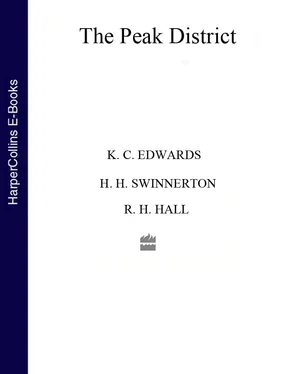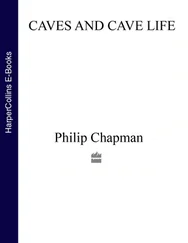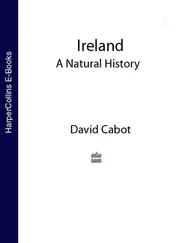1 The boundary of the Peak National Park
2 Geology of the Peak District
3 Volcanic rocks of The Peak
4 Geological section across the central Peak District
5 Surface relief
6 Distribution of the principal caves
7 Mean annual rainfall
8 Distribution of woodlands
9 Vegetation of Kinderscout Plateau
10 Site and plan of Bakewell
11 Lead rakes in the Castleton-Bradwell district
12 Water gathering grounds
13 Upper Derwent valley before and after reservoir construction
14 Features of interest
15 Areas of public access
Reference to a topographical map will be an advantage in perusing this book. The most suitable one for the purpose is the excellent Ordnance Survey One-Inch Tourist Map of the Peak District, published in 1957. This sheet, which is on a scale familiar to all ramblers and nature-lovers, shows the boundary of the National Park
THE SITUATION of the Peak District in the heart of England as an island of varied hill land, often of spectacular scenic charm, almost surrrounded by industrial lowland in whose cities and towns, often gloomy and grimy, live a quarter of Britain’s population, made it a natural choice for the first of our National Parks. The old geography books not infrequently referred to the Pennines as the “backbone of England” and here, at their southern end, the earth’s bony framework of older rocks appears not only at the surface, but towering to heights whose grandeur belie their modest elevation.
Nottingham is but one of the cities which adjoin the Peak District, but one from which there are natural lines of entry by some of the most charming valleys. Certainly the members of the University of Nottingham have long shown a particular interest in the area—since well before the University College became the University—and it is thus especially appropriate that Professor K. C. Edwards should head a team of his colleagues and friends to act as principal author as well as editor of this composite volume. As Professor of Geography he has spent most of his academic life at Nottingham and, as the pages of that successful journal The East Midland Geographer show clearly, he has done much to encourage the scientific study of the surrounding area, including the Peak District. In this he carries on the tradition established by the octogenarian Professor Emeritus of Geology, the author of the volume on Fossils in the New Naturalist Library, Professor H. H. Swinnerton, who now contributes two of the basic chapters in the present volume.
Four main rock types dominate the Peak District—coarse sandstones or “grits”, shales, massive limestones and, less conspicuous, the old volcanic rocks locally known as toad stones. It so happens that these rock types offer very different resistance to the forces of nature and so The Peak has become a region of sharp contrasts—from the intimate wooded dales to the windswept, boggy moorland heights. The habitats afforded are correspondingly rich and varied and so naturally are both plant and animal life and the response of man as farmer. Mineral wealth has added to the variety of man’s responses, so that in addition to its other attractions the Peak District exhibits fascinating fragments of the story of man’s occupation of the area from prehistoric times to the present.
A region of such difficult relief has long offered a challenge to man—in selecting sites for his settlements, in finding routes for his roads and railways, in utilising the varied scattered resources. Each of these aspects is taken up in turn and we are led to see clearly the competing claims on Peak District land—for farming, grazing, forestry, water supply, recreations, sport, nature conservation and others—and how the solution may lie in the careful application of the principles of multiple use within the framework of a National Park administration.
Although with the names of K. C. Edwards and H. H. Swinnerton only that of the botanist R. H. Hall appears on the title page, Professor Edwards has been able to incorporate observations by many workers in many fields, and the resulting volume is one which we are confident will have a very wide appeal. As his long association with the Ramblers’ Federation, the Youth Hostels Association and many field bodies will show, Professor Edwards believes the way to see and know The Peak is on foot. His book has thus a special appeal to the legions of ramblers who use the National Park every week-end, winter and summer alike.
THE EDITORS
SO MANY books have been written about Derbyshire and the Peak District that there would seem little excuse for adding to them. The reason for doing so lies in the promotion of a National Park in this area some years ago. This timely and widely-acclaimed decision has given official recognition to The Peak as one of the regions of outstanding scenery in Britain. It has also heightened the interest of those who find enjoyment in the open country and of the many people whose inclination is the study of wild nature. To thoughtful and observant people who require something more than the conventional guidebook, it is felt that an account of the present landscape of The Peak, of how it came into being and of the activities it supports, would be of some value. Moreover, the ground covered by this volume extends beyond the limits of Derbyshire, for the territory embraced by the National Park includes portions of several adjoining counties.
The plan of the book is intended to be simple and logical. The earlier chapters deal with the strictly natural aspects of the area from the story of the rocks to the formation of the present land surface and its vegetation cover. Then Man enters on the scene and the later chapters describe how in different ways Man has imposed, and continues to impose, his cultural imprint upon the setting prepared by Nature. The concluding chapter examines those aspects of The Peak which make it so acceptable to the community as a National Park.
In preparing the book much help has been given by various authorities on the area which is gratefully acknowledged. Chapters 2and 3have been written by H. H. Swinnerton, C.B.E., D.Sc, Emeritus Professor of Geology in the University of Nottingham; Chapter 6, together with parts of Chapters 5and 7, have been contributed by Mr. R. H. Hall, F.L.S., a specialist on the botany of The Peak, while the section on Fungi has been prepared by Dr. C. G. C. Chesters, Professor of Botany in the University of Nottingham. Mr. F. A. Sowter assisted with the section on Lichens. For the remaining chapters, two sources of information have proved invaluable. These are the unpublished thesis, The Peak District National Park: a regional study of an amenity area , by Mr. G. J. Mosley, M.A., of the University of Nottingham, and The Report and Analysis of Survey of the Peak Park Development Plan by John Foster, A.R.I.B.A., M.P.T.I., Planning Officer to the National Park Planning Board. Two local publications were also extensively used, the Journal of the Derbyshire Archaeological and Natural History Society (annually) and The Derbyshire Countryside (bi-monthly) of the Derbyshire Rural Community Council.
In preparing the Appendices on Bird Life and Fish Life in the Peak District I have been helped by Mr. E. L. Jones of the University of Nottingham, Mr. C. M. Swaine of the British Ornithologists’ Union and by Major J. I. Spicer, M.B.E., Chief Pollution and Fisheries Officer to the Trent River Board. I am most grateful to them, and also to Miss D. A. Clarke, Sub-Librarian at the University of Nottingham, for her kind assistance in assembling material and compiling the index.
Moreover, to the many friends and acquaintances who have generously made available their special knowledge of The Peak and to the numerous countryfolk encountered on the moors and in the dales who unwittingly contributed by their ready and forthright response to questions, grateful thanks are expressed.
Читать дальше












